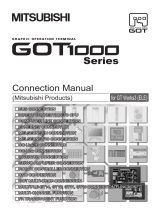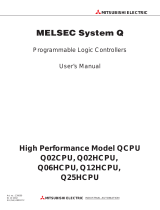
A - 14
6.6.4 Remote latch clear ............................................................................................................6 - 25
6.6.5 Relationship between remote operation and RUN/STOP status of the CPU module .......6 - 26
6.7 Q Series-compatible Module Input Response Time Selection (I/O Response Time) ............ 6 - 27
6.8 Error Time Output Mode Setting ............................................................................................6 - 29
6.9 H/W Error Time PLC Operation Mode Setting .......................................................................6 - 30
6.10 Intelligent Function Module Switch Setting ............................................................................ 6 - 31
6.11 Monitor Function .................................................................................................................... 6 - 33
6.11.1 Monitor condition setting ...................................................................................................6 - 34
6.11.2 Local device monitor/test ..................................................................................................6 - 40
6.11.3 External input/output forced on/off ....................................................................................6 - 43
6.11.4 Executional conditioned device test ..................................................................................6 - 48
6.12 Writing Programs While CPU Module is in RUN Status.........................................................6 - 58
6.12.1 Online change (ladder mode)............................................................................................6 - 58
6.12.2 Online change (files) .........................................................................................................6 - 61
6.12.3 Precautions for online change...........................................................................................6 - 63
6.13 Execution Time Measurement ...............................................................................................6 - 69
6.13.1 Program monitor list ..........................................................................................................6 - 69
6.13.2 Interrupt program monitor list............................................................................................6 - 72
6.13.3 Scan time measurement ...................................................................................................6 - 73
6.14 Sampling Trace Function ....................................................................................................... 6 - 77
6.15 Debug Function from Multiple GX Developers....................................................................... 6 - 91
6.15.1 Simultaneous monitoring from multiple GX Developers function ......................................6 - 91
6.15.2 Online change function from multiple GX Developers ......................................................6 - 93
6.16 Watchdog Timer (WDT) ......................................................................................................... 6 - 95
6.17 Self-diagnostic Function.........................................................................................................6 - 97
6.17.1 LEDs indicating errors.......................................................................................................6 - 104
6.17.2 Error clear .........................................................................................................................6 - 104
6.18 Error History........................................................................................................................... 6 - 105
6.19 System Protection..................................................................................................................6 - 106
6.19.1 Password registration........................................................................................................6 - 106
6.19.2 Remote password .............................................................................................................6 - 108
6.20 System Display of CPU Module with GX Developer..............................................................6 - 113
6.21 LED Indication........................................................................................................................ 6 - 116
6.21.1 Methods for turning off the LEDs.......................................................................................6 - 116
6.21.2 LED indication priority .......................................................................................................6 - 117
6.22 Interrupt from Intelligent Function Module ............................................................................. 6 - 119
6.23 Serial Communication Function.............................................................................................6 - 120
6.24 Service Processing ................................................................................................................ 6 - 128
6.24.1 Service processing setting ................................................................................................6 - 128
6.25 Initial Device Value................................................................................................................. 6 - 135
6.26 Battery Life-prolonging Function............................................................................................ 6 - 139
6.27 Memory Check Function........................................................................................................6 - 140
6.28 Latch Data Backup to Standard ROM Function .....................................................................6 - 141
6.29 Writing/Reading Device Data to/from Standard ROM ............................................................ 6 - 146
6.30 CPU Module Change Function with Memory Card ................................................................6 - 147
6.30.1 Backup function to memory card.......................................................................................6 - 149

























